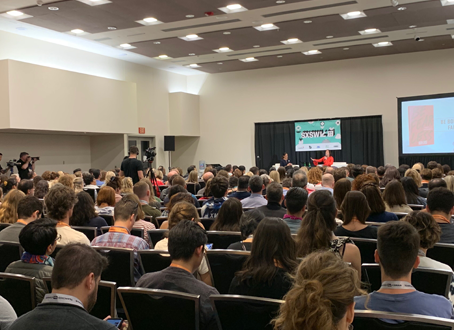This post was written by Abigail Hunter, Daniela Fernandez and J.D. Brady on behalf of the Case Foundation:
Earlier this month, members of the Case Foundation team attended the 2014 National Geographic Explorers Symposium— a two-day event with the world’s top explorers who are pushing the boundaries of knowledge and discovery. This year’s Explorers Symposium was part of the society’s 125th anniversary and a celebration of fearless adventurers, scientists, photographers and storytellers who are making a difference. The common theme shared among all their presentations: we must be innovative when addressing challenges.
Here’s a brief recap highlighting key takeaways:
Food for Thought
Author and activist, Tristram Stuart discussed one of the most critical challenges we face with our global food system: food waste. According to Stuart growing more food isn’t the solution to solve world hunger, instead reforming the current food distribution system is key. Jerry Glover, agricultural ecologist, also spoke on the importance of ensuring regional food security, emphasizing the challenges of population growth, soil erosion and soil degradation. In addition to discussing the importance of domestic and global food security, ecologist and epidemiologist Christopher Golden highlighted the connection between environmental changes in the wildlife and human well-being. Although each of the panelists brought forth unique perspectives, they all agreed on the principle of viewing world problems as opportunities for change rather than seeing problems as stagnant obstacles.
Innovative Approaches
Evolutionary biologist Ryan Carney, robotics engineer Robert Wood and multimedia artist Paul Miller (DJ Spooky) recounted new techniques in their respective fields that were fearless in their approach and pushing boundaries. Miller defined an explorer as someone who takes the established position of the world around them and pivots, which resonated with the theme of the panel. During the question and answer session all three addressed the question of risk in their work, stating that you must push past the risk to accomplish something worthwhile. As Robert Wood eloquently put it: “If we know how to do it, it’s not risky enough.”
Pushing Boundaries
Photographer Cory Richards, a pioneer in educating female populations in Afghanistan Shabana Basij-Rasikh and geographer Kendra McSweeney, who studied the effects of drug trafficking on cultures in Honduras explored the theme of “Pushing Boundaries.” The panel emphasized the emotional connection needed to push past obstacles and make a difference in local communities. Shabana told both the dangers she faced attending school in Afghanistan under the Taliban, and the work she is currently undertaking to help girls still affected by limited education opportunities.
Exploration in Progress
The final feature showcased a handful of speakers, who each spent up to three minutes giving “rapid fire updates” on their recent activities. Photojournalist Reza Deghati gave an especially memorable update on his work training refugee children in photography, video, and design so they can become visual storytellers. “I believe in the power of pictures for social change,” said Deghati while showing the audience photographs refugee children took of their surroundings. Another notable talk came from ethnobotanist Maria Fadiman, whose upcoming project will include a book that preserves the cultural, linguistic, and ecological heritage of the Ha people in Tanzania. Her project combines culture, language and photography as a means of addressing preservation issues.
With the wide variety of topics, the 2014 National Geographic Explorers Symposium evidenced the potential of collaborative and innovative projects to solve global challenges. We were honored to join these worldwide travelers along their journey. Learn more about the speakers HERE and follow @NatGeoExplorers on Twitter to stay connected and follow the explorers along the way.





